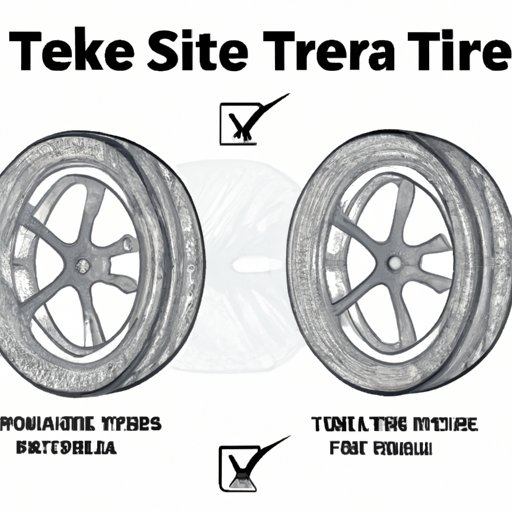
Introduction
Finding the correct tire size is crucial to ensure your vehicle performs to its best ability. In this article, we will explore how to identify your tire’s size effectively and understand the markings on your tire’s sidewall. We will also address common questions concerning tire sizes.
It’s important to be aware of the potential consequences of using the wrong size tire. Your safety on the road may be jeopardized, leading to accidents and damage to your vehicle. Choosing the correct size also means your car will handle better, giving you a smoother and more comfortable ride.
How to Locate Tire Size on Tire Sidewall
The first thing you need to do is locate the tire size on your tire’s sidewall. The tire size is a series of letters and numbers outlined on the tire’s sidewall. It may seem complicated at first, but it’s easy to find once you know what you’re looking for. Follow these instructions:
- Find the code that begins with “P” or “LT”, which indicates the type of tire.
- Next, look for the three-digit number which provides the width of the tire.
- The next number indicates the tire’s sidewall height. This is shown as a percentage of the tire width.
- The letter that follows denotes the tire’s construction.
- The final number refers to the diameter of the wheel in inches.
To make it even easier, refer to the detailed photo or illustration of the tire sidewall that even points out the different code’s position.
Understanding Tire Size Designation
It’s also essential to understand what each number and letter in the tire size code represents. This knowledge helps when making informed choices about replacing tires, modifying your wheels, etc.
This is a breakdown of each component of the tire size code:
- The code that begins with “P” or “LT” indicates the type of tire.
- The three-digit number indicates the width of the tire in millimeters.
- The next number indicates the aspect ratio, which is a percentage of the tire’s tread width.
- The letter after the aspect ratio indicates the tire’s construction. “R” means radial tire, “D” means diagonal tire, while “B” means bias belted tire.
- The final number indicates the wheel diameter in inches.
Tips for Identifying Correct Tire Size
The following will help when finding your tire size if the markings on your tire sidewall are unclear, damaged, or covered.
- Refer to your vehicle owner’s manual. There is a page listing the recommended tire sizes and types.
- Use an online tire size calculator by entering the vehicle make, model, and year. The calculator displays the perfect tire size for the vehicle.
- Consult a tire professional or mechanic. They have relevant equipment to identify the correct tire size for your vehicle.
Addressing Common Questions About Tire Size
There is a vast array of tires to choose from in today’s market, ranging in size, type, and design. This often prompts vehicle owners to seek answers to specific questions. Here are some frequently asked questions concerning tire size:
Can I change tire size?
While you can change tire size, this decision should be made carefully. Altering tire size can affect vehicle performance, fuel efficiency, and ride quality. Additionally, a tire that is too large may cause damage or stress to your vehicle’s suspension, steering, and brakes.
Do I need to replace all four tires at once?
No, it’s not always necessary to replace all four tires. However, it’s best to get a matching set, especially when it comes to tread depth. A new tire has a deeper tread depth than an older tire, leading to uneven wear. To maintain even wear and to ensure proper handling, it’s advisable to have a new set of tires or matching pairs.
Conclusion
Finding your tire size is an essential step in maintaining your vehicle’s safety and performance. If you plan on purchasing new tires or making modifications to your wheels, get the correct tire size first. Check your tire sidewall markings or consult your vehicle owner’s manual. If unsure, use an online tire size calculator or seek the advice of a tire professional.
Never compromise on safety. A correct tire size is the first step to ensure you arrive at your destination smoothly and safely.





